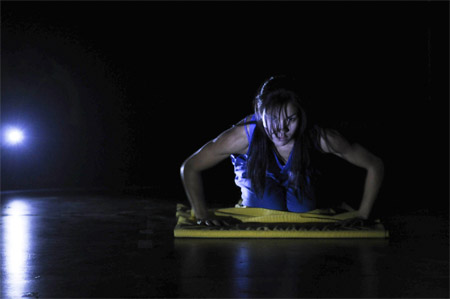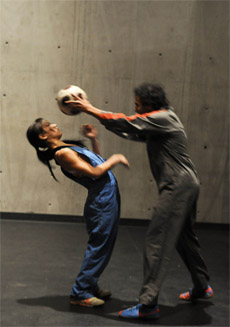sweat
 |
Branch Nebula |
hard artLeaving our critical hats at the door we entered Track 12, Carriageworks, to view Sweat, performance company Branch Nebula’s latest street culture and dance project-in-the-making. What followed were the research outcomes from their four- week residency at Performance Space, demonstrating their initial responses to a challenging task: marrying the project concept—young people trapped in low paid, tedious jobs—with the various skills of the cast, including parkour, breaking and football. The resulting series of self-contained sketches and dance solos were unified by a creative use of sound and light, treating us to a tiny taster of the polished performance yet to come. Like a backstage crew the performers began by wheeling in lights and an array of huge speakers. A fortress of sound, the speakers were arranged to house Hirofumi the ‘noisician’ and his live and loud industrial soundscape. For the duration Hirofumi responded to the performers and they in turn reacted to his noise, which undulated between panicked scratching, drilling and clanging metal sounds and indecipherable, haunting tones that (I can only imagine) echo around deserted factories late at night. Lighting was also interwoven with the sound apparatus and performance. At one point a small hand-held light was manoeuvred between the audience and a robotic, body-popping solo, creating a dancing monster silhouette on the wall behind. Later a performer jumped, flipped and swung between speaker boxes with acrobatic flare. When this parkour practitioner proceeded to scale the height of Carriageworks' Track 12 before hanging backwards from a beam the tension was palpable. In a similarly nerve-wracking display a woman stood pinned to the wall as her co-performer (in character as her boss) repeatedly slammed a football either side of her head, using ball skills to expose gender and power relations in the workplace. Other movements were inspired by the drudgery of specific jobs. Two performers with dust cloths beneath their feet began simultaneously break dancing and cleaning the floor, the slipperiness pushing the moves to extremes and adding an unpredictable edge. A dancer mechanically folding and unfolding her limbs together with a strip of yellow material simultaneously embodied factory worker and sewing machine. Through a combination of movement, sound and light Branch Nebula have at this early stage created moments that uncomfortably embody the loss of identity and voice in menial, underpaid employment while at the same time celebrating the transgressive power of creative expression. Josephine Skinner Translab Cross Cultural Residency Program, Performance Space: Branch Nebula, Sweat, co-creators Mirabelle Wouters, Lee Wilson, collaborators, choreographers Ahilan Ratnamohan, Erwin Fenis, David Vu, Marnie Palomares, Claudia Escobar, noisician Hirofumi, dramaturgs Deborah Pollard, Martin del Amo; Performance Space at CarriageWorks, June 26 For more on Branch Nebula see: other worlds, outer limits: Paradise City to shop, to die (for): Plaza Real |
 |
Branch NebulaAfter experiencing the research outcomes of the Branch Nebula residency at Performance Space, I asked co-creator Lee Wilson what the future holds for Sweat. InterviewBefore we discuss Sweat, how did Branch Nebula begin? Mirabelle Wouters and I founded the company in 1998 because we wanted to bring our different skills together to make work based on ideas. Our skills collectively include acrobatics, actor training, performance making, dance training, choreography and set, costume and lighting design. We had both been touring around Europe, myself with Acrobat and Mirabelle with the Belgian dance company Hush Hush Hush, and were exposed to a lot of exciting work; so we decided to make our own. At the time we believed in jumping in and making the kind of work we wanted to, we didn’t give a stuff as to whether we had the right training as choreographers. We had a DIY approach. What inspired you to work with young people? Initially because I wanted their virtuosic skills to be recognized artistically rather than [in terms of sport]. I also found when working in the Sydney clique of artists that not a lot of professional opportunities were going to younger and more diverse performers; there were never any auditions just companies working with the same groups. I wanted to work with physical performers and found that, for example, someone with martial arts and parkour training can be extremely exciting and capable to work with. These street styles are actually practiced by all ages and are not simply youth activities. We have plans for another project which will address our desire to work with a diverse range of ages. How did the concept for Sweat develop? The initial idea came during Howard’s regime when he introduced the Workplace Relations reforms. There was a particular incident when a young person working in a juice bar had their pay cut in half one day and was given the option to take it or leave it. That sparked the idea of investigating work as a physical language. Exploring who does low paid work led me to want an ethnically diverse cast. We specifically investigated young people doing that work; looking at who they are, beyond anonymity, to the skills, dreams and vitality oppressed by the drudgery of boring work. Can you describe your strategies for producing ideas and movement, and how working across different skill-sets informs this process? For this process dialogue was the foundation and analysis of what’s happening suggested the direction: I can see the way forward through what people say. There is integrity in the artists following their own line. I do try to shape and prod and sometimes they don’t agree but it’s great when the dialogue keeps the process moving. This work is also about art. Talking to the artists about their art—what makes them tick, frustrations, desires—helps me to see how to strengthen their input and to find new paths for them. It helps to analyse ideas together because we are working across multiple disciplines and it would be stupid of me to think I understand the depth of all these practices. Research was conducted across two main fronts, to investigate firstly workplace conditions and secondly how the skills held by the group could be extended choreographically and to come together, either contextualized by the setting we create or as a way of expressing the condition of the body under stress. Overall the most important thing is that we embody the ideas we are investigating rather than refer to or represent them. We want to give a sense of things happening in real time together with the audience, a visceral experience. Noise, alteration of the space, shifts in light, movements, all of these things affect us together. We are all under stress and find moments of respite together. Light and sound were creatively incorporated into the performances. In what way are they important to your working idea of Sweat? Lighting and sound go a long way to shaping how we feel when we are creating on the floor. These elements generate atmosphere and are important to be developed in tandem with the performative ideas. Light and sound are not adjuncts, they are performers unto themselves: not a soundtrack, not a design, but generators of energy in the space. We don’t think of the purpose of lighting is to light the performers but to create an architectural space that they exist within. Alternatively it can play a role such as interrogating or probing a subject. Can you explain the process of working with the noisician Hirofumi? Hiro has been involved with the noise world for over a decade and has a highly developed practice across many fronts; he designs and builds effects pedals and noise machines for which he actually forges the steel. I don’t want the process of bringing something into the theatre to soften or dampen what makes noise art exciting, unsettling and extreme so I tried to separate out what might be a boundary for Hiro and what might be an aesthetic principal. To Hiro’s credit, he wants to experience a new and exciting process. For example, he does our daily yoga training where we quickly realized that he has a strong background in full contact karate. This interest in martial arts is another route into the group. Hiro engages in all our discussions about the content and research; he gives feedback on ideas and absorbs this information to pursue his own line of enquiry. Following this initial development stage what do you have planned for Sweat? As to the nuts and bolts, I'll muse it over for the next couple of months. But I am tempted to focus on completely different areas like the visual aspect of the work, playing with industrial materials, plastic, liquid, chemicals and objects. The next stage is a Creative Development in October, funded by the Australia Council for the Arts. We are currently seeking funds for the third phase that will take it to public presentation. Performance Space has committed to a two week run in CarriageWork’s Bay 20, October 18-31, 2010. For future touring Branch Nebula continues its relationship with Performing Lines, who produced the Sydney Opera House season and the national and Brazilian tours of Paradise City. A number of national presenters are already interested so we are confident the work will have an extended touring life. Images by Heidrum Lohr, courtesy of Branch Nebula Video edited by Denis Beaubois, displayed with the permission of the artists |








 back
back